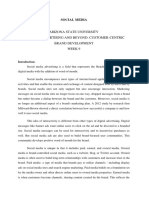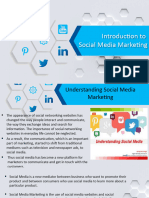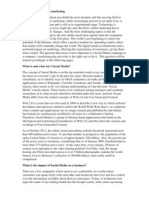What Is Social Media
What Is Social Media
Uploaded by
Udeshika UpamaliOriginal Description:
Copyright
Available Formats
Share this document
Did you find this document useful?
Is this content inappropriate?
Report this DocumentCopyright:
Available Formats
What Is Social Media
What Is Social Media
Uploaded by
Udeshika UpamaliCopyright:
Available Formats
What Is Social Media?
Social media is any digital tool that allows users to quickly create and share
content with the public. Social media encompasses a wide range of websites and
apps. Some, like Twitter, specialize in sharing links and short written messages.
Others, like Instagram and TikTok, are built to optimize the sharing of photos and
videos.
What makes social media unique is that it is both broad and relatively
uncensored. While many social media companies impose some limitations—
such as taking down images that display violence or nudity—there are much
fewer limitations on what someone can share than there with other means of
mass communication like newspapers, radio stations, and television channels.
Anyone with internet access can sign up for a social media account. They can
use that account to share whatever content they choose to, and the content they
share reaches anyone who visits their page or profile.
The use of hashtags on social media groups content together by topic, allowing
users to connect with strangers who are sharing content related to a topic of
interest.
How Social Media Works
Since social media covers so many different kinds of websites and applications,
the function of these tools also varies. However, most social media sites start
with a user creating a profile, usually by providing a name and an email address.
Once a profile has been created, users can create and share content. For
instance, an Instagram user with a new account can take a picture and share it
on their profile with a caption. In addition to creating content for their profile,
social media users can find other users whose content they want to follow or
comment on. Depending on the type of social media, a user may "follow" another
user, add them as a "friend," or they may "subscribe" to another user's page.
Social media often uses "feeds" that allow users to scroll through content. Social
media companies use algorithms, based on a user's profile data, to determine
the content that appears and the order that it appears in. The feed will include
content from "followed" users, as well as from entities that pay to promote their
content.
Types of Social Media
There are many different types of social media, and many services could fit into
multiple categories. Here are a few of the major types, along with some
examples.
Social Networks
Social networks specialize in connecting and exchanging thoughts, ideas, and
content with other users—often with users who share tastes and interests.
Facebook and Twitter are examples of social networks. Though more
professional than others, LinkedIn may be considered a social network, as well.
Media Networks
As opposed to social networks, which specialize in letting users share and
exchange raw thoughts and ideas, media networks specialize in distributing
content like photographs and videos. Instagram and YouTube are examples of
this. A YouTube user, for example, will upload a video they've created, and other
users can "like," "dislike," or comment on the video. If they enjoy the video
enough, a user may choose to "subscribe" to the creator, so that new videos
from that creator appear in their feed.
Discussion Networks
Discussion networks like Reddit are the ideal outlet for posts that can spark in-
depth discussion among users. Users can leave detailed responses in the
comment section, and other users can respond directly to those comments,
allowing for conversations to grow and develop organically.
Blogging sites like WordPress may also be included in the discussion network
category, though some would consider blogging its own type of social media.
Review Networks
Review networks like Yelp and TripAdvisor add social media aspects to user
reviews of products and services. Users can interact directly with those leaving
reviews, as can the businesses being reviewed.
Businesses and Social Media
While any individual can sign up for social media, social media platforms have
become an important part of marketing for businesses of all sizes. The key to
successful social media is to not treat it like an extra appendage but to treat it
with the same care, respect, and attention you do all of your marketing efforts.
Here are some things businesses should keep in mind while using social media.
Social Media Marketing Is Fleeting
By its nature, social media is a short attention span media—you have to catch
their attention as they're quickly scrolling through dozens of posts at a time. Ad
headlines and copy are harder to fit into an attention-grabbing tweet than a
traditional newspaper ad.
You Must Be Active on Social Media
One of the biggest mistakes retailers make is to open up accounts on every
social media platform they think is relevant and then leave them alone with no
activity. In fact, social media users may be turned off by the retailer who opens
accounts and does not engage with clients or the public.
It may be better to not have a social media icon on your website if you are not
going to actively engage with it on a daily basis.
Focus on the Customer
Another big mistake retailers make is to use social media to talk about what is
important to them rather than talking about what is important to the
customer. Retailers who use social media, for instance, may think it is great to
spread the word about a sale. In some ways, this would be true, but if that's the
only reason you are getting involved in social media, it won't be beneficial. Your
goal should be to provide content that is relevant to your customer and engage
with them to the point that they want to share your post with others.
If you use social media, you need to engage with your customers, involve them in
a dialogue, and ask them for their opinions. Post a picture of two items you are
considering carrying in your store and ask customers which one they like best.
This creates a dialogue that leads to shared posts and engaged followers. Plus, if
you successfully engage with your customers, it will help you better identify their
tastes and preferences.
Images Are Key
Another thing to consider is that the most commonly-shared content on social
media is an image, so it's a good idea to include an image with your posts.1 This
will dramatically increase your chances that one of your followers will share the
post with their network. While building up a large network of followers is great, a
better measure of social media success is how often your followers share your
content—no matter how many followers you have. This is the new form of "word
of mouth."
Key Takeaways
Social media is a website or application that allows you to create and
share content while engaging with other users.
The type of media being shared depends on the social media site or
application in question.
Unlike traditional mass media outlets, social media allows almost anyone
to instantly reach the public, and there are relatively few restrictions on the
content.
Businesses can use social media to engage with customers.
Definition - What does Communication Media mean?
Communication media refers to the means of delivering and receiving data or
information. In telecommunication, these means are transmission and storage tools or
channels for data storage and transmission.
Techopedia explains Communication Media
Different media are employed for transmitting data from one computer terminal to the
central computer or to other computer systems inside some kind of network.
There are two forms of communication media:
Analog: Includes conventional radio, telephonic and television transmissions
Digital: Computer-mediated communication, computer networking and telegraphy
The most commonly used data communication media include:
Wire pairs
Coaxial cable
Microwave transmission
Communication satellites
Fiber optics
The communication media acts as a channel for linking various computing devices so
that they may interact with each other. Contemporary communication media facilitate
communication and data exchange among a large number of individuals across long
distances via email, teleconferencing, internet forums and many other forms of
communication.
You might also like
- Cancellation of Deed of SaleDocument2 pagesCancellation of Deed of Salebrenton67% (3)
- Inflation Sensitive AssetsDocument547 pagesInflation Sensitive AssetsFabien Musoke100% (2)
- Internship Presentation PPT FormatDocument26 pagesInternship Presentation PPT FormatRamesh NaiduNo ratings yet
- Social MediaDocument27 pagesSocial MediaHayden Coombs100% (2)
- Social Media Has Improved Human CommunicationDocument10 pagesSocial Media Has Improved Human CommunicationRaees KhanNo ratings yet
- Paper PresentationDocument19 pagesPaper Presentationnandi durga98No ratings yet
- E2 IELTS - 20 Speaking TopicsDocument10 pagesE2 IELTS - 20 Speaking TopicsYusuf Ziya DilbazNo ratings yet
- Businesses and Social MediaDocument3 pagesBusinesses and Social MediaMiyangNo ratings yet
- What Is Social MediaDocument7 pagesWhat Is Social Mediaarmelimperial1No ratings yet
- Social Media: By: Aditya Narendra KotianDocument10 pagesSocial Media: By: Aditya Narendra KotianAditya KotianNo ratings yet
- The Effect of Social Media in The Studies and Lifestyle ....Document18 pagesThe Effect of Social Media in The Studies and Lifestyle ....melchieNo ratings yet
- What Is Social Media?: Share Content QuicklyDocument2 pagesWhat Is Social Media?: Share Content QuicklyMiyangNo ratings yet
- Mba 1Document33 pagesMba 1Hrithik ChaurasiaNo ratings yet
- Social Media ArpanDocument16 pagesSocial Media Arpanpawansekhon920No ratings yet
- It Era Module 3Document10 pagesIt Era Module 3Josh Marey JalopNo ratings yet
- MKT 365 - Asu - Assignment - 2024 - Week 9 - Social MediaDocument22 pagesMKT 365 - Asu - Assignment - 2024 - Week 9 - Social Mediametalzero512No ratings yet
- Social Media MarketingDocument26 pagesSocial Media Marketingnanekaraditya06No ratings yet
- Social Media MarketingDocument27 pagesSocial Media Marketingnanekaraditya06100% (1)
- DM Social MediaDocument12 pagesDM Social MediaAnoop AnilNo ratings yet
- Popular Social Media PlatformsDocument5 pagesPopular Social Media PlatformsAdeel Chughtai100% (1)
- Social Platform by ARYANDocument21 pagesSocial Platform by ARYANaryandehimiwal26No ratings yet
- Chapter 11 NotesDocument6 pagesChapter 11 NotesNoor MirzaNo ratings yet
- Social Networking For Social Integration ReviewerDocument13 pagesSocial Networking For Social Integration ReviewerAntoinette MuñozNo ratings yet
- Digital Marketing (7. Social Media Marketing)Document102 pagesDigital Marketing (7. Social Media Marketing)nanekaraditya06100% (1)
- Social Media Marketing 3Document16 pagesSocial Media Marketing 3Mr NasrullahNo ratings yet
- SFC Presentation 1: 1. Professionals 2. Sharers 3. Creators 4. BondersDocument4 pagesSFC Presentation 1: 1. Professionals 2. Sharers 3. Creators 4. BondersSamuel Muabia PlānetNo ratings yet
- PR and Social MediaDocument6 pagesPR and Social MediaLill GalilNo ratings yet
- Trends of Social Platforms.Document4 pagesTrends of Social Platforms.Aditya DasNo ratings yet
- Term Paper in Social Media MarketingDocument22 pagesTerm Paper in Social Media MarketingSean Khaine Dela CruzNo ratings yet
- Social Media MarketingDocument18 pagesSocial Media MarketingKC GutierrezNo ratings yet
- The Benefits of Social Network MarketingDocument8 pagesThe Benefits of Social Network MarketingYashwant KumarNo ratings yet
- Week 1 - Introduction To Social Media MarketingDocument3 pagesWeek 1 - Introduction To Social Media Marketingjayashreeshegokar1976No ratings yet
- Social Media For The BusinessDocument36 pagesSocial Media For The BusinessCarlo Niño GedoriaNo ratings yet
- IntroductionDocument47 pagesIntroductionkeerat preet kaurNo ratings yet
- Social Networking: Shah Hanan U Zaman (230423)Document14 pagesSocial Networking: Shah Hanan U Zaman (230423)Shah Hanan U ZamanNo ratings yet
- BU 5th semCS 3Document12 pagesBU 5th semCS 3max90binNo ratings yet
- Are Social Media The New Market?: © APR 2020 - IRE Journals - Volume 3 Issue 10 - ISSN: 2456-8880Document7 pagesAre Social Media The New Market?: © APR 2020 - IRE Journals - Volume 3 Issue 10 - ISSN: 2456-8880Vaishnavi KalokheNo ratings yet
- Advertising-Platform Grade 11Document16 pagesAdvertising-Platform Grade 11cyriaaNo ratings yet
- What Is Social NetworkingDocument6 pagesWhat Is Social NetworkingPriyadarsini KNo ratings yet
- Ms Word 2Document5 pagesMs Word 2SUTHEKA .SNo ratings yet
- Social MediaDocument91 pagesSocial MediaRajaNo ratings yet
- Social Media ProjectDocument5 pagesSocial Media ProjectAlexa SferleNo ratings yet
- STUDY ON SOCIAL MEDIA MARKETING FinalDocument9 pagesSTUDY ON SOCIAL MEDIA MARKETING FinalSunil KumarNo ratings yet
- Study On Social Media Marketing of Amazon..............................Document15 pagesStudy On Social Media Marketing of Amazon..............................Sunil KumarNo ratings yet
- Social MediaDocument80 pagesSocial MediaChandanaNo ratings yet
- Social MediaDocument3 pagesSocial MediaJam BautroNo ratings yet
- Social Media: Sara GuitarraDocument15 pagesSocial Media: Sara GuitarraSaraGuitarraNo ratings yet
- Social Media Strategies: Engaging Customers in the Digital AgeFrom EverandSocial Media Strategies: Engaging Customers in the Digital AgeNo ratings yet
- Main ProjectDocument17 pagesMain ProjectOluwayomi OgunsholaNo ratings yet
- First or Next Draft of External Deliverable - Week 5 Work-In-ProgressDocument22 pagesFirst or Next Draft of External Deliverable - Week 5 Work-In-Progressapi-594288109No ratings yet
- Social MediaDocument36 pagesSocial MediashrutismitanaikNo ratings yet
- Mba IntroductionDocument24 pagesMba IntroductionSanthu SaravananNo ratings yet
- SIMPLIFIED SOCIAL MEDIA MARKETING: FOR CONTENT CREATORS & SMALL BUSINESS OWNERSFrom EverandSIMPLIFIED SOCIAL MEDIA MARKETING: FOR CONTENT CREATORS & SMALL BUSINESS OWNERSNo ratings yet
- Social NetworkingDocument5 pagesSocial Networkingkirtanwale1311No ratings yet
- Social Media and Web AnalyticsDocument7 pagesSocial Media and Web AnalyticsNAUSHAD SHEKHNo ratings yet
- Introduction To Social Media Awareness 1Document5 pagesIntroduction To Social Media Awareness 1Dhruv SinghNo ratings yet
- Final Requirements IN Empowerment Technologies: Submitted By: Laica M. RavanillaDocument13 pagesFinal Requirements IN Empowerment Technologies: Submitted By: Laica M. RavanillaLaica RavanillaNo ratings yet
- Social Media MarketingDocument24 pagesSocial Media MarketingKristine Grace100% (1)
- Chapter - 1Document58 pagesChapter - 1Ahmed GulzarNo ratings yet
- Chapter 3Document12 pagesChapter 3Chandru ChandruNo ratings yet
- Role of Social Media in Consumer Buying Behaviour For Cosmetics ProductsDocument10 pagesRole of Social Media in Consumer Buying Behaviour For Cosmetics ProductsHossain ArifNo ratings yet
- Final Out Social Media MarketingDocument60 pagesFinal Out Social Media MarketingKingsten JonesNo ratings yet
- Perception Towards Social Media Marketing Project PDFDocument49 pagesPerception Towards Social Media Marketing Project PDFalifahadmz04No ratings yet
- Answer 10Document2 pagesAnswer 10Udeshika UpamaliNo ratings yet
- Additional 10Document2 pagesAdditional 10Udeshika UpamaliNo ratings yet
- Mock Exam 5Document4 pagesMock Exam 5Udeshika UpamaliNo ratings yet
- Additional 8Document2 pagesAdditional 8Udeshika UpamaliNo ratings yet
- Udeshika Upamali Writing 2Document3 pagesUdeshika Upamali Writing 2Udeshika UpamaliNo ratings yet
- Answer 8Document2 pagesAnswer 8Udeshika UpamaliNo ratings yet
- Task 2Document2 pagesTask 2Udeshika UpamaliNo ratings yet
- Answer 7Document2 pagesAnswer 7Udeshika UpamaliNo ratings yet
- Answer 5Document2 pagesAnswer 5Udeshika UpamaliNo ratings yet
- FGS MSSC Lisc 2018 003Document9 pagesFGS MSSC Lisc 2018 003Udeshika UpamaliNo ratings yet
- Engineering ManagementDocument3 pagesEngineering ManagementArvin LanceNo ratings yet
- Conflict of Laws Hizon PDFDocument52 pagesConflict of Laws Hizon PDFMarinelMarquezNo ratings yet
- Equality and DiversityDocument9 pagesEquality and DiversityJames OtunNo ratings yet
- Chapter 2 - Project Life CycleDocument36 pagesChapter 2 - Project Life Cyclehailegebrael100% (1)
- The Concept of Self Defense in International Law and South China Sea Analysis Mary Fides A QuintosDocument3 pagesThe Concept of Self Defense in International Law and South China Sea Analysis Mary Fides A QuintosEjaz KazmiNo ratings yet
- Whose Side Are You On?Document1 pageWhose Side Are You On?Charlie SoederNo ratings yet
- SocializationDocument9 pagesSocializationFemi BalogunNo ratings yet
- Impact of Social Issues in EducationDocument6 pagesImpact of Social Issues in EducationJanice EscañoNo ratings yet
- History of Philippine LiteratureDocument12 pagesHistory of Philippine LiteratureChirrelyn Necesario SunioNo ratings yet
- Gmail - Invitation - Pool Campus Placement Drive - Denso India Pvt. Ltd. - 19-February-2024 - @sunderdeep Group of Institutions, GhaziabadDocument2 pagesGmail - Invitation - Pool Campus Placement Drive - Denso India Pvt. Ltd. - 19-February-2024 - @sunderdeep Group of Institutions, Ghaziabadtyt522458No ratings yet
- Extinguishing Financial Liabilities With Equity Instruments: IFRIC Interpretation 19Document8 pagesExtinguishing Financial Liabilities With Equity Instruments: IFRIC Interpretation 19rosettejoy278No ratings yet
- Battletome: Slaves To Darkness: Official Errata, July 2020Document4 pagesBattletome: Slaves To Darkness: Official Errata, July 2020Shawn SpearsNo ratings yet
- Korean Language Institute Yeugnam University: Personal InformationDocument6 pagesKorean Language Institute Yeugnam University: Personal InformationSaood AliNo ratings yet
- I - Identify The Following Accounts As A. Assets, Liabilities, Capital, Revenue, Expense, Other Income B. Debit or Credit C. Nominal or Real AccountDocument2 pagesI - Identify The Following Accounts As A. Assets, Liabilities, Capital, Revenue, Expense, Other Income B. Debit or Credit C. Nominal or Real AccountAries KeiffNo ratings yet
- OB PresentationDocument20 pagesOB PresentationTamanna Islam SuchiNo ratings yet
- Spouses Balila v. IACDocument5 pagesSpouses Balila v. IACANDREA JOSES TANNo ratings yet
- Answers To BLA Questiosn For Ch. 5Document4 pagesAnswers To BLA Questiosn For Ch. 5Phương HeoNo ratings yet
- Url - Profile - CBD Stores To Extract Sheet Yellowpages CBD No EmailDocument21 pagesUrl - Profile - CBD Stores To Extract Sheet Yellowpages CBD No EmailWafiboi O. EtanoNo ratings yet
- Sanjay CVDocument4 pagesSanjay CVkrahulsharma11No ratings yet
- Land Law 8repeatDocument17 pagesLand Law 8repeatTaruna ShandilyaNo ratings yet
- Review Questions NBCDocument19 pagesReview Questions NBCMitz ZieNo ratings yet
- Pre-Baseline Assessment of Learners For Accelerated Learning Program Village ProfileDocument3 pagesPre-Baseline Assessment of Learners For Accelerated Learning Program Village ProfileJunaid AhmedNo ratings yet
- Cost of Doing Business in BangladeshDocument5 pagesCost of Doing Business in BangladeshRokan uddinNo ratings yet
- Timeline of WWII - WWII FoundationDocument10 pagesTimeline of WWII - WWII Foundationdhaneesh22No ratings yet
- Activity 15Document6 pagesActivity 15MinzaNo ratings yet
- Session 11 UGBS 101Document9 pagesSession 11 UGBS 101andreotabilNo ratings yet
- Why Teenagers Should WorkDocument2 pagesWhy Teenagers Should WorkBhavneet KaurNo ratings yet



































































































